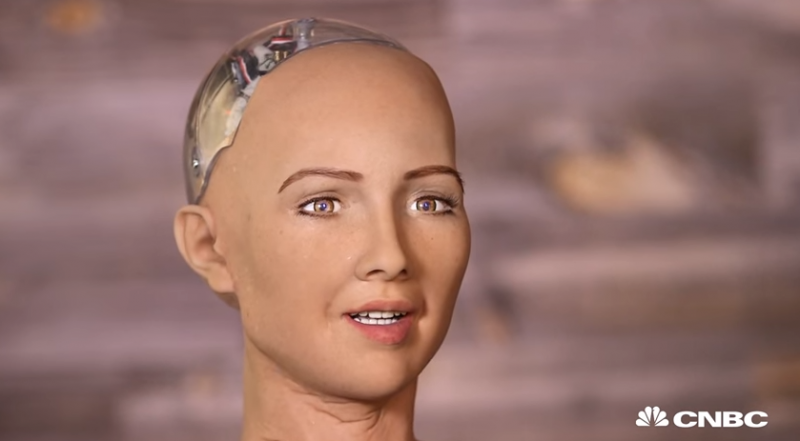March 21, 2016 weblog
Humanoid Sophia is given primary role of talking to people

An essay on robots by a professor in Japan over 40 years ago caused a stir in science circles when he explored what draws us and repels us when it comes to robots.
Yasahiro Mori's paper, "The Uncanny Valley," said that in climbing toward the goal of making robots appear human, he noticed our affinity increases until we come to what he called the uncanny valley.
Mori maintained that humans were drawn are to human-like robots with positive feelings of affinity until the robot revealed itself in such a way that triggers the person's realization that it is not human. Then it becomes creepy and affinity is lost.
Nonetheless, the robot-making world has new insights, new faces, new visions, of humanlike robots smoothing communication between humans and computers, which can be assigned for reasons of therapy and customer service applications.
"Robotics is finally reaching the mainstream and androids - humanlike robots - are everywhere at SXSW," said the notes to a CNBC video about Dr. David Hanson of Hanson Robotics. He was presenting in the video Sophia, which CNBC said was the most advanced android to date from the team at Hanson Robotics.
He said he does believe there will be a time when robots are indistinguishable from humans. "They will walk among us, they will help us." He said they will teach, play, help us put groceries away.
Sophia is a robot which appears as a white woman who speaks English in an American accent. The accent is standard, free of regional quirks. Sophia says talking to people is her primary function. The robot said it feels like it can be a good partner to humans —to help humans smoothly integrate and make the most of all the new technological tools and possibilities.
One striking feature evident in Sophia is eye expression, where the eyes appear to blink and half-wink and emote as Sophia speaks. The robot smiles, registers surprise, and other expressions. It has cameras in the eyes. Algorithms allow it to see faces; it can make eye contact.
"Two cameras in her eyes track facial movements and expressions, which allows her to respond appropriately to conversations. The patented rubber material that makes up her face, known as 'frubber,' makes for an incredibly realistic human-look without trying to trick users into believing she's anything more than a robot thanks to the visible, encased circuitry in the back of her head," wrote William Hoffman in Inverse. CNBC similarly said her skin is made from patented silicon.
According to the CNBC report, Sophia can emulate more than 62 facial expressions.
Hoffman made the point that Sophia can learn as she continues to talk with other people, "so SXSW was the perfect gathering to mine some crucial data."
CNBC reported that a combination of Alphabet's Google Chrome voice recognition technology and other tools enable Sophia to process speech, chat and get smarter over time.
Hoffman said that Hanson is hoping that by getting robots out to the public more, it not only teaches robots to care about humans but it also helps humans break down the social barriers associated with robotic interactions. Hanson Robotics' stated mission is "to create a better future for humanity by infusing artificial intelligence with kindness and compassion, achieved through millions of dialogs between our robots and the people whose lives they touch."
Hanson said his preference nonetheless was to make them look a little bit like robots, so you know.
© 2016 Tech Xplore



















